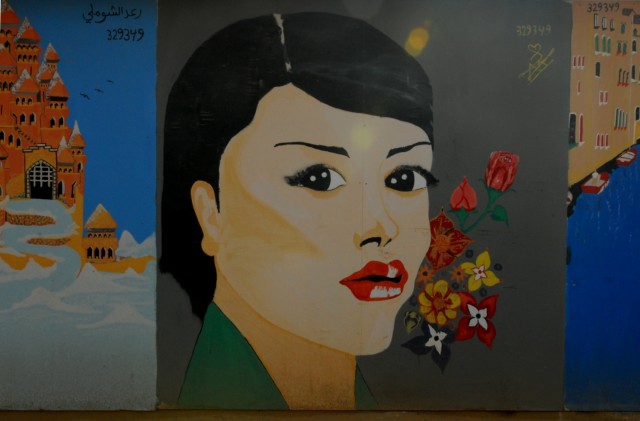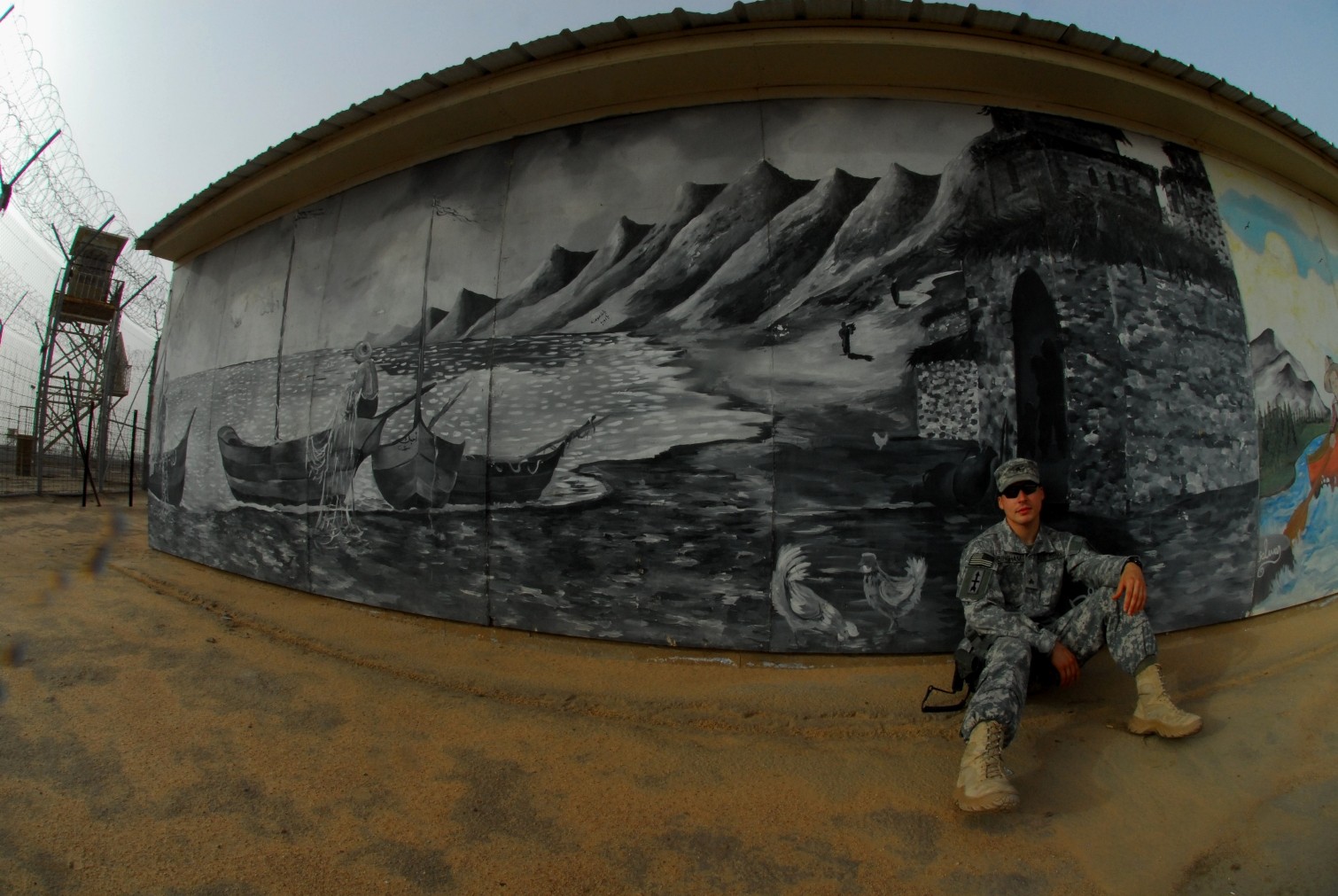CAMP BUCCA, Iraq (Army News Service, March 9, 2010) -- Since Sept. 16, Iraqi civilian and U.S. military deconstruction teams have transformed the landscape surrounding the rusting, chain-link walls of the theatre interment facility here to piles of rubble.
That day, the last prisoners of the TIF boarded the detainee air transport north-bound for Camp Cropper, near Baghdad. The Camp Bucca detention center, located in United States Division-South near the city of Umm Qasr, was officially shut down.
Today it is a ghost town punctuated by splashes of color on the many buildings within the concertina-topped fences.
The color comes from nearly five years of detainees putting paint brushes to the outer plywood walls to create hundreds of murals on buildings around the interment facility.
"The detainees painted all of the murals in the compounds and a significant majority of the murals outside," said Lt. Col. Kenneth King, commander of the 306th Military Police Battalion.
Looking out on the wide, dirt access-roads between the compounds, and the constricted footpaths winding between them, peers a six-foot vignette of an elephant in orange, tan and green.
Elsewhere, under the shadow of a metal-framed guard tower is an impressively realistic black and white mural depicting birds flying above fishermen on the shore.
"I inherited a number of them when we arrived on Christmas of 2008," said King. "Many of them were quite impressive and of high quality. "
King, the final commander of the TIF, said the art played an important role for the detainees.
"It was one way to let them express themselves," he said, "It gave them something to help pass the time and the opportunity to have some degree of input regarding their environment."
King was preceded as TIF commander by Col. Rodney Faulk, who was at Bucca from 2007 to 2008.
"The detainee's always had a proclivity for art," said Faulk, deputy commander of the 300th MP Brigade.
At the time, Faulk served as chief of staff when Col. Jim Brown, then-commander of the 18th MP Bde., oversaw the facility. He said that it was during Brown's tenure that the murals were painted.
"He was working hard on giving the detainees alternatives to violence," he said.
According to Faulk, Brown didn't give the detainees any guidance on what could and could not be painted.
"They were able to express the nature of the human spirit," said Faulk, "This manifested itself in many ways."
Numerous murals depicted scenes about water and it is not uncommon for a wall to display as many as four works from different artists.
"I always found a couple of themes," said Faulk. "One of the common themes was of American and Iraqi partnership. Another theme was about good versus evil and talked about stamping out violence."
"I recall seeing what looked like Iraqis and American Soldiers killing a serpent which is a traditional symbol of evil," he said.
Other times, the images were less figurative and more literal.
"They would also branch out and paint other subjects, such as children and beautiful women," said Faulk. "If you look real close, there is a unique style."
Even some of the cement-floored buildings were adorned by flowered vines painted around the interior door frame.
Among the number of people who passed through the detention center, a few were practiced painters. One of the most prolific artists was known by the pseudonym "Mohammed Pecaso."
The entrance to Compound 12 features one of his works on two large concrete barriers turned from their usual gray to a bright yellow scene of Iraqi and American cooperation sealed with a handshake.
"'Mohammed Pecaso' was a detainee who had some knowledge of painting," said Maj. Corey Schultz, media and marketing officer at Army Reserve Communications, office of the chief, Army Reserve, in Washington, DC.
From 2007 to 2008, then-captain Schultz worked with Faulk, serving as the public affairs officer for the 300th MP Bde.
"The supplies were mostly donated, from Soldiers and folks back home," said Schultz.
Pecaso "kind of ran things" at the art school, Faulk said, and, just as some of the student's murals had deeper meaning, so did the school.
"Beyond the art, there was job skill training, education and explanation of good governance," Faulk said.
The vocational school, later called the Centurion Skills Institute, taught a variety of trades including tilling, carpentry, reading, drawing and painting.
There was even a project that combined vocational training and creating gifts for the detainees' families.
"'Bucca Bears' were made by detainees in another class that we offered: sewing," King said, "They were not for sale to Soldiers -- a [would-be] violation of General Order One -- but were given to children when families visited detainees."
"They were made from materials within the TIF -- predominantly the yellow blankets and cloth," he said.
The facility even had a brick factory in which the bricks produced were used both in building the factory's walls and in rebuilding projects in the cities around the province.
The aim of the vocational training was to empower detainees in preparation for their departure from Bucca.
"What we were essentially doing in 2008 was moving from an EPW [enemy prisoner of war] to a corrections model," Schultz said, "Trying to assess and prepare the detainees so that, upon release, they had some marketable skills and could support themselves that way, rather than being paid by insurgents to dig holes for IEDs."
Faulk agreed.
"There are a lot of stories that [seem to] say we think we've changed a person overnight but we're not that naAfA-ve," he said. "You can teach someone to read and give them a skill and they might still go out and plant IEDs."
The TIF personnel hoped that the skills detainees learned while incarcerated put them in a position to refuse the dangerous jobs as an insurgent mercenary.
According to Schultz, the change in the re-interment rate during this time was "statistically significant", dropping from 8-10 percent down to 1.5-3 percent.
The vocational programs not only prepared detainees for their time after leaving Bucca, but also promoted their safety, and that of the TIF personnel, during their stay.
Boredom quickly set in during detention. If left unchecked, it would be a security concern and also not in keeping with the intention of the Geneva Convention, said Faulk.
"All along, the American Soldiers have operated according to the spirit of the Geneva Convention and executed safe care and custody of detainees," he said. "The programs are just a manifestation of that custody."
The policies of the Geneva Convention also have an enormous effect on the future of the art.
"We cannot sell it," said Faulk, "First, because it was produced with government funds, even though a nominal amount. Second, the Geneva Convention prohibits the exploitation of detainees, so we could not have an exhibit."
The policy did not, however, prohibit the MPs from setting one of the pieces aside.
"It's small but it is a part of the unit's history," said Faulk.
As the Iraqi civilian and Army deconstruction teams move closer to their mission of tearing down the TIF, it is likely that there may be no choice but to reduce the art to rubble.
However, even if the names of artists like Mohammed Pecaso are torn down, the real legacy is in the people who passed through the TIF, said Faulk.
"Pecaso was released, and that is a good thing," he said. "I got to be there for his release. It's a record of transformation from an insurgent to a man of peace, and I hope that it holds true for the rest of his life."
(Spc. Samuel Soza writes for 367th MPAD)




Social Sharing